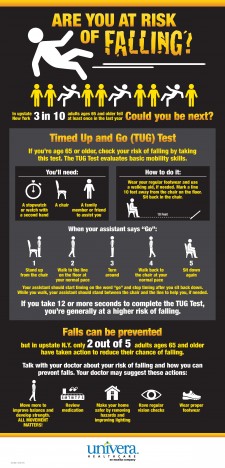
BUFFALO, N.Y., March 6, 2018 (Newswire.com) - Six in 10 upstate New York adults ages 65 and older report that they have not taken steps to reduce their risk of falling and three of 10 adults in the same age group fell at least once in the past year, according to a review of New York state data by Univera Healthcare.
“About 30 percent of those falls resulted in injury,” said Bruce Naughton, M.D., Univera Healthcare vice president and chief medical officer of the company’s Medicare division. “Falling does not have to be an accepted part of the aging process. Older adults can work to improve their balance and develop their strength by incorporating more movement into daily activities. Also, they can do things to reduce tripping hazards in and around their homes.”
Falling does not have to be an accepted part of the aging process. Older adults can work to improve their balance and develop their strength by incorporating more movement into daily activities. Also, they can do things to reduce tripping hazards in and around their homes.
Bruce Naughton, M.D., Vice president and chief medical officer for Medicare
The most common tripping hazards include:
- Throw rugs that bunch or slide.
- Clutter.
- Stairs that are uneven, are too steep or too long, and have inadequate railings.
- Lighting that’s either too dim, or so bright that it causes glare.
- Pets that follow too closely or lie in prime walking areas.
- Unstable chairs or tables that can’t support a person’s weight.
- Extension cords across walkways.
- Bathrooms that lack grab bars, or have low toilet seats.
- Sloping yards and driveways.
- Cracks in sidewalks.
- Uneven transitions between bare floors and carpeted rooms.
Naughton, a specialist in geriatric medicine, is a proponent of the Timed Up and Go (TUG) Test, used to evaluate basic mobility skills and the risk of falling among older adults.
“All you’ll need is a stopwatch or watch with a second hand, a chair, and a family member or friend to assist you with the TUG Test,” said Naughton. Wear your regular footwear and use a walking aid, if needed. Then mark a line that’s 10 feet away from the chair on the floor.
Timed Up and Go “TUG” Test:
- Sit in the chair
- When your assistant says “Go”: standup from the chair
- Walk to the line on the floor at your normal pace
- Turn around
- Walk back to the chair at your normal pace
- Sit down again
“Your assistant should start timing on the word “Go” and stop timing after you sit back down,” said Naughton. “If you take 12 or more seconds to complete the TUG test, you might be at a higher risk of falling, and should seek your doctor’s advice on actions you can take to reduce that risk.”
Lower body weakness and difficulty with balance are risk factors for falling, according to Naughton. He suggests taking a walk around the house during television commercial breaks or standing on one leg, and then the other, for as long as you can while doing the dishes or ironing. Proper vision care, up-to-date eyeglass prescriptions, proper nutrition and a thorough medication review can help reduce the risk of falling.
The risk for falling and the severity of an injury increase with age.
Of upstate New Yorkers ages 65 to 69:
- 28 percent fell in the last 12 months
- 32 percent that fell were injured from the fall
Of upstate New Yorkers ages 80 and older:
- 32 percent fell in the last 12 months
- 40 percent that fell were injured from the fall
“People need to stay active as they age, keep their doctors informed about any issues with balance, vision or medications, and eliminate easy tripping hazards around the house and yard to reduce their chances of suffering fall-related injuries,” said Naughton.
# # #
Media Contacts: Peter Kates (716) 857-4485 or Kandis Fuller, APR (716) 857-4410
Source: Univera Healthcare
Share: